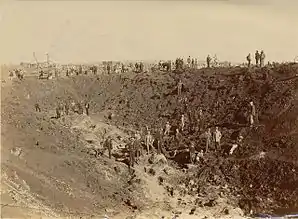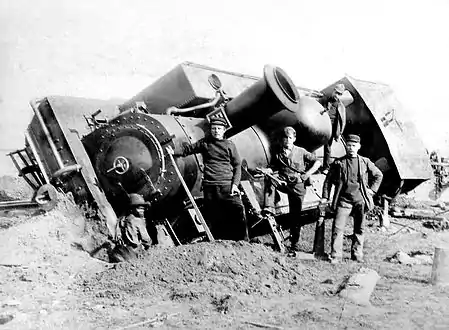Braamfontein Explosion
The Braamfontein Explosion was an explosion in Braamfontein, a suburb of Johannesburg, in 1896. It was one of the largest non-nuclear explosions in history.



Explosion
On 16 February 1896, a freight train with eight trucks of dynamite - 2300 cases of 60lb each, or about 60 tonnes - was put in a siding at Braamfontein railway station. The dynamite was destined for nearby mines, but the mine's stores of dynamite were already full so the train was left in the siding - for days, in very hot weather - until there was somewhere to store the dynamite.[1]
On the afternoon of 19 February, after labourers had started to unload the train, a shunter came to move it to another part of the siding; but after the impact of the shunter, the dynamite exploded. The explosion left a crater 60 metres long, 50 metres wide and 8 metres deep. The explosion was heard up to 200 kilometres away.
Suburbs as far away as Fordsburg were seriously damaged, and about 3,000 people lost their homes.[2]
Memorials
Accounts vary, but it is thought that over 70 people were killed[3] and more than 200 were injured. A memorial at the Braamfontein cemetery reads that 75 "whites and coloured" were killed.[4]
In 2012, artist Eduardo Cachuco created "Explosion, 1896", a complex artwork based on the explosion which was shown at the "looking glass" exhibition.
References
- "A Nauseous Pit of Death – the Braamfontein Dynamite Explosion". Archived from the original on 21 April 2013. Retrieved 12 February 2013.
- "Dynamite explosion in Braamfontein".
- "Dynamite explosion". City of Johannesburg. Retrieved 12 February 2013.
- "The Dynamite Explosion Memorial in Braamfontein Cemetery". Archived from the original on 29 April 2013. Retrieved 12 February 2013.